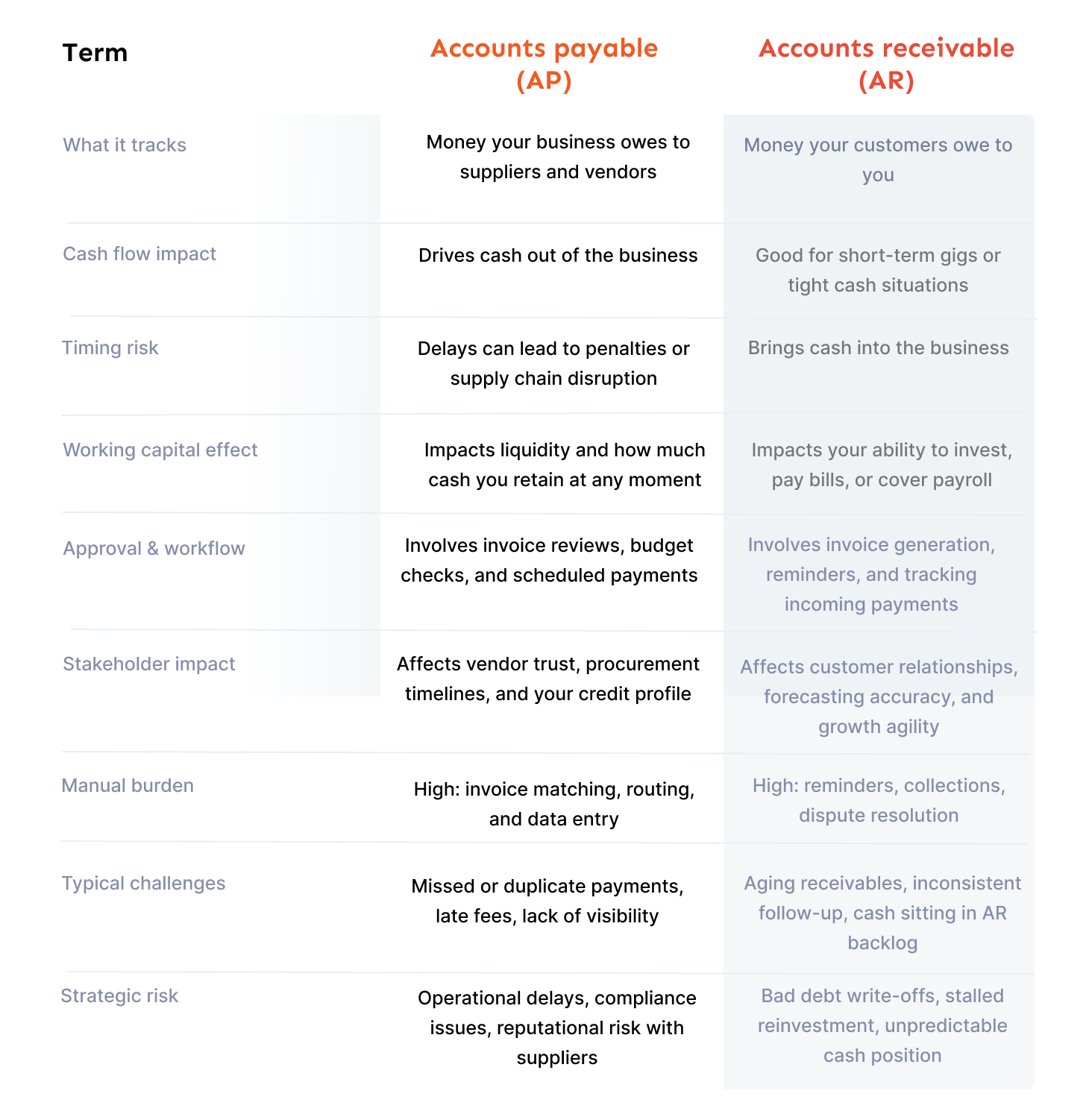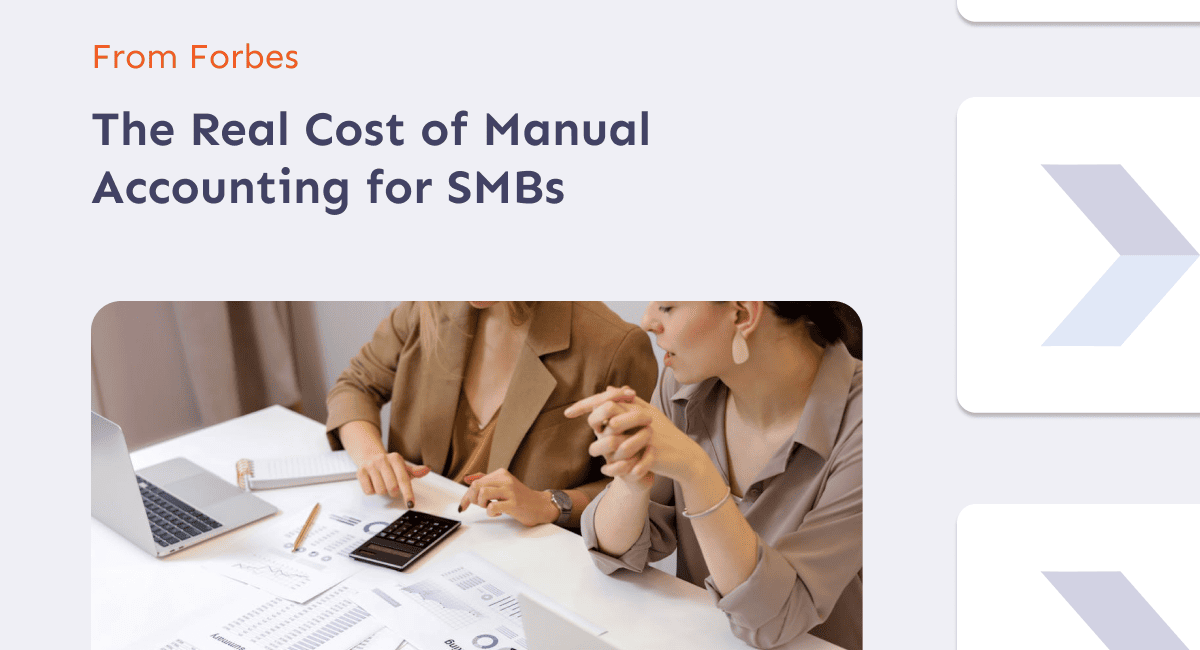Are you really tracking your financials optimally? Being a small or mid-sized business, it’s not only important to track where money goes and where it comes from, but also the pillars of any financial system – Accounts Payable (AP) and Accounts Receivable (AR). These two processes may sound simple, but they are the most important for any financial system.
Accounts payable vs accounts receivable is a critical question for cash flow, vendor relationships, and long-term financial health. As businesses expand and so do their operations expand, and managing AR and AP becomes increasingly difficult to handle. They become too time-consuming and prone to errors.
That’s why many businesses are turning to automation, but the big question is, which should you automate first?
Accounts payable: What you owe and why it matters
Accounts Payable (AP) refers to the money your business owes to other businesses, whether it’s a vendor, supplier or service provider. It’s an essential part of your operations, and managing it well helps build trust, maintain smooth operations, and strengthen your financial credibility.
But when it is neglected or handled manually, it becomes a source of friction: missed payments, vendor disputes, late fees, and inconsistent procurement. It might hurt vendor relationships, operational continuity, and reputation.
Common Pain Points in Manual AP:
- Approvals are delayed due to mail-in inboxes or paper trails.
- Errors in data entry or duplicate payments
- Inability to track due dates
Accounts receivable: What you’re owed and why it needs attention
Accounts Receivable (AR) is the function that refers to what customers owe you after a product or service has been delivered. In simple terms, it’s expected income, which hasn’t yet turned into actual cash in your account.
For many small and mid-sized businesses, AR is where things often get stuck. You’ve done the work and sent the invoice, and now you’re waiting and waiting.
When managed well, AR creates stability. You know when money is coming in, you can cover expenses, and you can plan your business growth and expenses. But when AR is neglected, it creates cash flow gaps, operational stress, and lost time chasing payments.
Common AR management challenges:
- Invoices sent late or with errors
- Inconsistent follow-up processes
- Lack of visibility into who owes what and for how long
- Revenue is recognized in the books but not reflected in the bank.
Accounts payable vs accounts receivable: a comparative snapshot
AR and PR are the basis of any financial system. It is essential to understand how these two systems differ, and where they intersect, it is essential before deciding where to introduce automation.
Here’s how AP and AR compare across key dimensions:

Which should you automate first: Accounts payable vs accounts receivable?
Most mid-sized businesses know they need automation, but when both AP and AR are time-consuming and critical to operations, the real question becomes: Where should we start?
The short answer? It depends on which process is creating more friction or financial risk.
Start with the bigger problem
When deciding whether to do accounts payable automation or accounts receivable automation first, the best place to start is with the area causing the most friction. Focus on the biggest bottleneck, the process that’s consuming the most time, creates the most errors, or damages trust with partners or customers.
When to automate accounts payable first
AP is often the first process that finance teams automate, and for good reason.
- High volume of invoices: If you’re processing dozens or hundreds of vendor payments per month, AP is likely eating up staff hours.
- Multi-level approvals: Manual routing delays payments and frustrates stakeholders.
- Missed or duplicate payments: Errors are common when invoices are entered or approved manually.
- Strained vendor relationships: Late payments or lack of transparency create tension with key suppliers.
By automating AP, you can fix the above challenges and make the process more seamless.
When to automate accounts receivable first
If cash is consistently tight or unpredictable, AR automation can deliver a more immediate financial impact.
- Unpredictable cash flow: You invoice regularly, but the payments trickle in slowly or not at all.
- High DSO (Days Sales Outstanding): Customers are taking too long to pay, hurting your working capital.
- Manual collections: Your team spends hours every week following up on unpaid invoices.
- Missed follow-ups: Inconsistent reminder systems result in overdue accounts or bad debt.
By automating AR, you can send invoices promptly and consistently, automate reminders and follow-ups, track outstanding payments in real-time, and identify risky accounts before they become write-offs.
AR automation is particularly valuable for companies that offer Net 30/Net 60 terms, serve many clients, or have long sales cycles.
A phased approach
For many mid-sized businesses, the smartest path is to automate AP first, which is typically more structured and easier to fix quickly. Once that’s under control, you can move on to AR, which often requires more nuanced handling of customer relationships and cash behavior.
However, if you’re experiencing cash flow stress or missed revenue targets, starting with AR may be the better move because it directly addresses inflows, which ultimately power your business.
There’s no one-size-fits-all answer. But automation should always start where the payoff is highest and where the pain is loudest.
It’s time to level up
Accounts Payable and Accounts Receivable are not just accounting terms; they’re operational levers. When managed manually, they become bottlenecks. When automated, they become tools for scale, transparency, and trust.
Start with the process that’s costing you the most time or trust.
With Forwardly, you can streamline both AP and AR with ease. Pay vendors instantly, for free. Hold onto cash longer with flexible scheduling and approval workflows. You stay in control while avoiding late fees and capturing early-pay discounts.
On the AR side, automation means faster payments with no extra fees. Set up automatic payments and you’ll boost productivity up to 10x by syncing with your accounting software, eliminating payment delays and confusion.
 Back to Blog
Back to Blog


